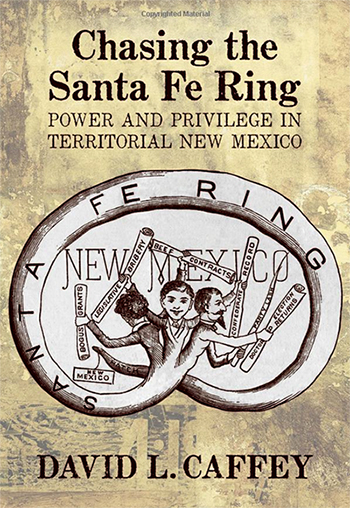
This week we ask author David L. Caffey some questions about his detailed, fast moving and fascinating book called Chasing the Santa Fe Ring: Power and Privilege in Territorial New Mexico, from UNM Press, 2014.
New Mexico Mercury: The Santa Fe Ring has been an item of history, so to speak, for years, but little was really known about its roots and complications until you undertook this riveting full length study. What are the most interesting responses to Chasing the Santa Fe Ring you’ve had so far?
David L. Caffey: Since I started work on the topic about nine years ago, responses have ranged from cautionary advice about being too judgmental, to insistence that the corruption of the Ring was common knowledge and that I should proceed to “hang ‘em high.” Most responses post-publication have been positive, but an anonymous reviewer on Amazon pronounced the book “a complete whitewash and disappointment.” The Santa Fe Ring was not an organized entity but a phenomenon named and described by its critics. The subject invites discussion and disagreement.
NMM: What drew you to undertake such an exhaustive study of this infamous period in New Mexican history?
DLC: References to the Santa Fe Ring in the territorial press are common, particularly during and just after the Ring’s most active and successful phase, approximately 1872 to 1884. The Ring is often mentioned by historians of the territorial period in New Mexico and Western American history, but such references frequently lack specificity. I thought someone should make a more extensive effort to reduce the legend and lore of the Ring to specifics of who, what, when, and to what effect? That’s what I tried to do.
NMM: Why has the Santa Fe Ring been so romanticized and popularized?
DLC: The core activity of men reputed to be Ring “members” was manipulation of Spanish and Mexican land grant claims and U.S. public land laws, but the field of attractive commercial opportunities extended to mining, stock raising, and corruption in fulfillment of federal supply contracts. The Santa Fe Ring naturally assumed the role of a general bogeyman in corrupt business and political activity. Presumed Ring men figured prominently in the Lincoln County War, so the Ring naturally translated into an obvious villain or antagonist in popular fiction and movies on Billy the Kid and the turmoil in Lincoln County. We can assume that most public perceptions concerning the Ring are owed to such popular sources.
NMM: Were other rings of land barons and speculators in the Mountain West as successful and as notorious in their states as the Santa Fe Ring was, and is, in ours?
DLC: Based on the notoriety that grew up around New York’s Tweed Ring in the 1860s and 1870s, it became common to designate any perceived sinister clique as a “ring.” The designation was applied to groups operating in particular localities—like the Denver Ring and the Tucson Ring—or sometimes to specific industries—like the Chrome Steel Ring, or the Alaska Fur Seal Ring. Most “rings” were narrowly focused. A greater breadth of activity and the longevity of its core leadership gave the Santa Fe Ring a more prominent place in New Mexico history and legend, compared to the political cliques said to dominate other western territories in the late 1800s.
NMM: Was the existence and notoriety of the Santa Fe Ring a factor of political resistance in Washington to statehood for New Mexico?
DLC: Most men to whom Ring membership was attributed were strong proponents of statehood, but they were sometimes their own worst enemies. There were those in Congress who feared that corrupt men would dominate if New Mexico became a state, with greater home rule authority and full representation in Congress. In 1876, as Congress was considering a statehood bill, a New York Times writer opined that if New Mexico was admitted, “we shall see a couple of rich mining superintendents representing another rotten borough in the Senate, and another knot of crossroads politicians annually dividing among themselves the spoils of office.” For this and other reasons, statehood was not attained until 1912.
Chasing the Santa Fe Ring is available at bookstores or directly from the University of New Mexico Press at unmpress.com or 800.249.7737.
Chasing the Santa Fe Ring Book Talk and Signing
Saturday, July 19, 2014, 2–4 p.m.
Lincoln Historic Site, US 380, Lincoln, NM
Free with admissions
For more information, please call 575.653.4025



Responses to “Five Questions with New Mexico Authors – David L. Caffey”